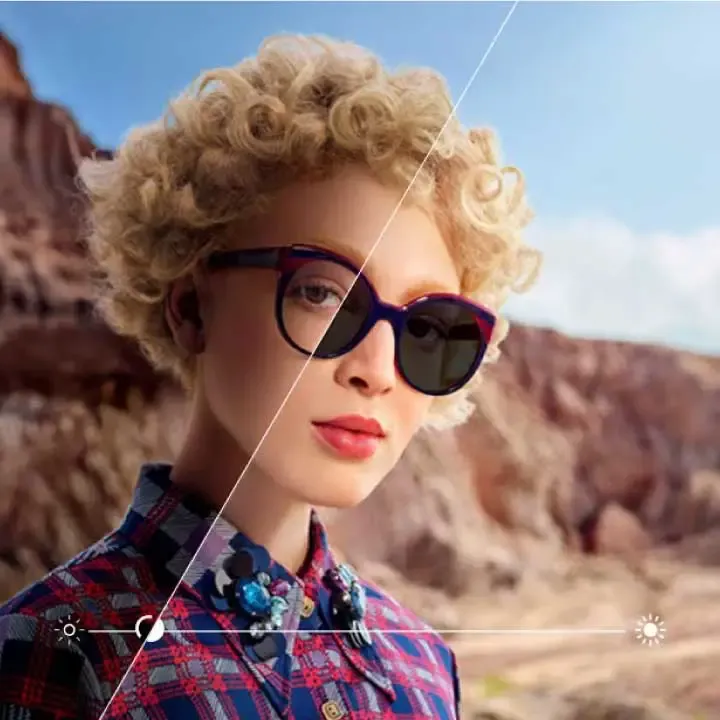Are you tired of switching between sunglasses and your regular glasses every time you step outside? Photochromic lenses might just be the solution you need. These smart lenses automatically adjust their tint when exposed to sunlight, offering both convenience and protection in one package. In this blog, we’ll explore everything you need to know about photochromic lenses—from how they work and their benefits to the drawbacks and cost considerations.
So, let’s dive in and explore!
Contents
What are Photochromic Lenses?

Photochromic lenses are innovative eyeglasses that automatically adjust their tint based on the level of ultraviolet (UV) light they are exposed to. Essentially, these lenses darken in sunlight and return to a clear state indoors or in low UV conditions.
The technology behind photochromic lenses involves special molecules embedded in the lens that change structure when exposed to UV light, causing the lens to darken. This adaptability makes photochromic lenses extremely useful for people who move between indoor and outdoor environments frequently, providing both convenience and protection from the sun’s harmful rays without the need for separate sunglasses.
What Does a Photochromic Lens Do?

Photochromic lenses are designed to provide both convenience and protection by automatically adjusting their tint based on the light conditions. Here’s what these dynamic lenses do:
- Automatic Tint Adjustment: In the presence of UV light, such as when stepping outdoors on a sunny day, these lenses darken to transform into sunglasses, reducing glare and increasing comfort by filtering out bright sunlight. Conversely, when you go back indoors where UV light is minimal, the lenses quickly fade back to clear, allowing for optimal vision in lower light conditions.
- UV Protection: Beyond convenience, these lenses offer continuous protection against harmful UVA and UVB rays, regardless of tint level.
- Enhanced Eye Comfort: By adjusting their tint, photochromic lenses reduce eye strain in varying light conditions, making them ideal for those frequently transitioning between indoor and outdoor environments.
Overall, photochromic lenses serve as a multi-functional tool in eyewear, providing visual comfort and protection while adapting to changes in light to enhance visual clarity in diverse environments.
Benefits of Photochromic Lenses

Photochromic lenses offer several significant advantages that enhance daily visual comfort and provide practical benefits for users in various environments:
- Convenience: One of the standout benefits is, that they eliminate the need to carry multiple pairs of glasses. This feature is particularly beneficial for those who frequently move between different lighting conditions.
- UV Protection: Photochromic lenses offer built-in UV protection, automatically blocking harmful UVA and UVB rays. This continuous protection helps prevent eye conditions linked to UV exposure, such as cataracts and macular degeneration, regardless of whether the lenses are clear or darkened.
- Eye Strain Reduction: By automatically adjusting tint according to light levels, photochromic lenses help reduce eye strain. Users experience less squinting in bright conditions, which is especially advantageous during activities like driving, where changing light conditions are common.
- Visual Comfort in Diverse Environments: Photochromic lenses provide optimal visual comfort by adapting to the surrounding light conditions. This adaptability ensures clearer vision both indoors and outdoors, enhancing visual clarity and reducing the need for frequent adjustments to one’s glasses.
Overall, the multifunctional nature of photochromic lenses makes them an excellent choice for anyone looking to improve their visual experience while simplifying their daily routines.
How UV Light Damages Your Eyes

Exposure to ultraviolet (UV) light can have significant adverse effects on eye health. Here’s how UV light can harm your eyes:
- Cataracts: One of the most common UV-related eye conditions is cataracts, a clouding of the eye’s lens that impairs vision. Long-term UV exposure accelerates the formation of cataracts, which can lead to decreased vision quality and potentially require surgery.
- Macular Degeneration: UV light can also contribute to the development of age-related macular degeneration (AMD), a leading cause of vision loss in older adults. This condition affects the macula, the part of the retina responsible for clear central vision.
- Photokeratitis: Sometimes called “snow blindness,” photokeratitis is akin to a sunburn of the eyes. It’s a temporary but painful condition caused by short-term high-level exposure to UV light, such as from sunlight reflecting off snow or water.
- Pterygium: UV exposure can lead to the growth of pterygium, a benign growth that originates on the white of the eye and can extend onto the cornea. This growth can cause irritation, redness, and in severe cases, can interfere with vision.
- Pinguecula: This is a yellowish, small bump on the white of the eye. Often seen in people who spend a lot of time outdoors, pingueculae are benign but can become inflamed and uncomfortable, known as pingueculitis.
Protecting your eyes from UV light with photochromic lenses or other UV-blocking eyewear is essential in preventing these conditions and maintaining long-term ocular health. These lenses ensure that your eyes are shielded from harmful rays regardless of whether you’re indoors or outdoors, providing peace of mind and contributing to overall eye safety.
Disadvantages of Photochromic Lenses
While photochromic lenses offer many benefits, they also come with certain limitations and drawbacks:
- Slower transition times in cold temperatures.
- Dependency on UV exposure for activation, which may not occur behind UV-blocking car windshields.
- Higher initial cost compared to standard lenses.
- May not darken as effectively on overcast days or in shaded areas.
- Limited range of tint colors available.
- Potential for reduced lifetime effectiveness with extensive use, requiring replacement to maintain optimal performance.
Conclusion
Choosing the right kind of lens is crucial for maintaining good eye health and ensuring optimal visual comfort. Ignoring the signs of discomfort or vision changes can lead to serious, long-term damage to your eyes. It’s essential to recognize when your eyes are telling you they need better support and protection.
Are your eyes craving attention? It’s time to prioritize your eye health! For a comprehensive eye examination and personalized lens recommendations, visit the Best Eye Hospital in India. Book your free appointment today or call us at +91 9711116605.
FAQs
Is Photochromic Good for Driving?
Photochromic lenses can be useful for driving during the day as they adjust to changing light conditions, reducing glare from sunlight. However, because they require UV light to activate and most car windshields block UV rays, they may not darken adequately inside a vehicle. For driving, especially facing direct sunlight, polarized sunglasses might be more effective.
Can You Wear Photochromic Lenses at Night?
Yes, you can wear photochromic lenses at night as they will remain clear in low light or indoor conditions without UV exposure. However, they do not enhance night vision and do not have any special properties to improve visibility in darkness beyond what typical prescription glasses would offer.
What Color Photochromic Lenses are Best?
Gray and brown are the most common colors for photochromic lenses, each suitable for different needs. Gray maintains true color perception and is good for general use, while brown enhances contrast and depth perception, making them ideal for conditions where light changes frequently.
Which is Better, Polarized or Photochromic Lenses?
The choice between polarized and photochromic lenses depends on your specific needs. Polarized lenses reduce glare from reflective surfaces, making them excellent for water activities and driving under bright conditions. Photochromic lenses offer the convenience of adjusting to changing light conditions, providing both clear and sunglass-like capabilities. For constant outdoor use in sunny conditions, polarized might be better, while photochromic lenses are more versatile for general wear in varying light conditions.
